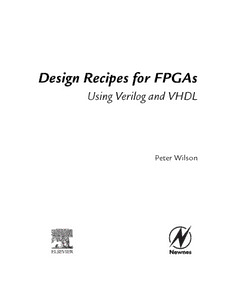Table Of ContentDesign Recipes for FPGAs
Using Verilog and VHDL
Peter Wilson
Firstedition2007
Secondedition2016
©2016ElsevierLtd.
Previousedition:Copyright© 2007PeterR.Wilson
PrintedandboundintheUnitedKingdom
ISBN:978-0-08-097129-2
Preface to the Second Edition
Theoriginalideabehindthefirsteditionofthisbookwastocollectsomeoftheuseful
methodsfordesigningdigitalsystemsusingFPGAsthatIhadaccumulatedovertheyearsand
hadbeenpassingontostudentsinourcoursesattheUniversityofSouthampton.Asaresult,
theoriginalbookwaswrittenusingVHDL,asthiswasveryoftenthehardwaredescription
languageofchoiceforuniversitystudentsandformanycourses(aswasthecaseat
Southampton).
Theinterveningtimehasseenthedevelopmentofotheroptions,suchasSystem-Cor
System-Verilog(plusthecontinuingpopularityofVerilog).Oneofthecommonquestions
tomewas“WhyistherenotaVerilogeditionofthisbook?”.Ihavethereforetakenthe
opportunitywiththesecondeditiontointroduceVerilog,towidentheapplicabilityofthe
booktoasmanydesignersaspossible.
Thesecondeditionalsooffersthechancetocorrecterrorsandtakeonboardthenumerous
reviewsoverthepastsevenyearssincethefirsteditionwaspublished.Forthesecomments
andsuggestionsIammostgratefultothereadersofthebook.FPGAshavealsomovedonin
leapsandboundssincethefirstedition,andthisalsogivesanopportunitytoupdatesomeof
thetechnologicalbackgroundandcorrecterrorsinthefirstedition.
Aboveallelse,thisbookwasnotandisnotintendedtobeatextbookfordigitalsystems
design,butratherausefulhandbookfordesignerstodipinandusewhereveritcanhelp.
IsincerelyhopeyoufindthisbookusefulandgoodluckwithyourFPGAdesigns!
PeterWilson
UniversityofBath
Preface to the First Edition
Thisbookisdesignedtobeadesktopreferenceforengineers,studentsandresearcherswho
usefieldprogrammablegatearrays(FPGAs)astheirhardwareplatformofchoice.Thisbook
hasbeenproducedinthespiritofthe“numericalrecipe”seriesofbooksforvarious
programminglanguages–wheretheintentionisnottoteachthelanguageperse,butrather
thephilosophyandtechniquesrequiredinmakingyourapplicationwork.Therationaleofthis
bookissimilarinthattheintentionistoprovidethemethodsandunderstandingtoenablethe
readertodeveloppractical,operationalVHDLthatwillruncorrectlyonFPGAs.
Itisimportanttostressthatthisbookisnotdesignedasalanguagereferencemanualfor
VHDL.ThereareplentyofthoseavailableandIhavereferencedthemthroughoutthetext.
ThisbookisintendedasareferencefordesignwithVHDLandcanbeseenascomplementary
toaconventionalVHDLtextbook.
PART 1
Overview
Thefirstpartofthebookprovidesastartingpointforengineerswhomayhavesomedigital
experiencebutnotnecessarilywithFPGAsinparticular,orwitheitherofthelanguages
featuredinthisbook(VHDLandVerilog).Whilethebookisnotintendedtoteacheither
language,“primers”aregiveninbothasaidesdememoiretogetstarted.Anoverviewofthe
maindesignapproachesandtoolflowsisalsoprovidedasastartingpoint.
CHAPTER 1
Introduction
1.1 Overview
Thebookisdividedintofivemainparts.Intheintroductorypartofthebook,primersare
givenonFPGAs(field-programmablegatearrays),Verilogandthestandarddesignflow.In
thesecondpartofthebook,aseriesofcomplexapplicationsthatencompassmanyofthekey
designproblemsfacingdesignerstodayareworkedthroughfromstarttofinishinapractical
way.Thiswillshowhowthedesignercaninterpretaspecification,developatop-downdesign
methodologyandeventuallybuildindetaileddesignblocksperhapsdevelopedpreviouslyor
byathirdparty.Inthethirdpartofthebook,importanttechniquesarediscussed,worked
throughandexplainedfromanexampleperspectivesoyoucanseeexactlyhowtoimplement
aparticularfunction.Thispartisreallyatoolboxofadvancedspecificfunctionsthatare
commonlyrequiredinmoderndigitaldesign.Thefourthpartonadvancedtechniques
discussestheimportantaspectofdesignoptimization,thatis,howcanImakemydesign
faster,ormorecompact?Thefifthpartinvestigatesthedetailsoffundamentalissuesthatare
implementedinVHDLandVerilog.ThisfinalpartisaimedatdesignerswithalimitedVHDL
orVerilogcodingbackground,perhapsthoselookingforsimplerexamplestogetstarted,orto
solveaparticulardetailedissue.
1.2 Verilog vs. VHDL
Oneofthelongeststanding“arguments”betweenengineersindigitaldesignhasbeenthe
issueofwhichisbest—VerilogorVHDL?Formanyyearsthiswaspartlyageographical
divide,withNorthAmericaseemingtobemainlyusingVerilogandEuropegoingmorefor
VHDL,althoughthiswasnotuniversalbyanymeans.Inmanycases,theEuropeanacademic
communitywastrendingtowardVHDLwithitseasyapplicabilitytosystemleveldesign,and
theperceptionthatVerilogwasreallymorea“lowlevel”designlanguage.Withtheadventof
SystemVerilogandtheproliferationofdesigntools,theseboundariesandargumentshave
largelysubsided,andmostengineersrealizethattheycanuseIPblocksfromeitherlanguage
inmostofthedesigntools.Ofcourse,individualswillalwayshavetheirownpreferences;
howeveritistruetosaythatnowitisgenuinelypossibletobelanguageagnosticanduse
whicheverlanguageandtoolstheuserprefers.Moreoftenthannot,thechoicewilldependon
4 Chapter1
threemainfactors:(a)theexperienceoftheuser(forexample,theymayhaveabackgroundin
aparticularlanguage);(b)thetoolsavailable(forexample,sometoolflowsmaysimplywork
betterwithaparticularlanguage—SystemVerilogforinstancemaynotbesupportedbythe
toolsavailable);and(c)corporatedecisions(wherethecompanyorinstitutionhasa
preferenceforaspecificlanguage,andinturnthismaymeanthatlibrariesmustbeina
specificformatandlanguage).Forresearchers,thereisaplethoraofinformationonalldesign
languagesavailable,withmanyexampledesignspublishedontheweb,makingitrelatively
simpletouseoneoranotherofthemainlanguages,andsometimesevenamixtureof
languages(usingprecompiledlibraries,forexample).Ofcourse,thisisalsoavailableto
employeesofcompaniesandfreematerialisnowwidelyavailablefromsourcessuchasOpen
Cores(http://www.opencores.org),theFreeModelFoundry(http://www.freemodelfoundry.
com/)andtheOpenHardwareRepositoryatCERN(http://www.ohwr.org/).
1.3 Why FPGAs?
Therearenumerousoptionsfordesignersinselectingahardwareplatformforcustom
electronicsdesigns,rangingfromembeddedprocessors,applicationspecificintegrated
circuits(ASICs),programmablemicroprocessors(PICs),FPGAstoprogrammablelogic
devices(PLDs).ThedecisiontochooseaspecifictechnologysuchasanFPGAshoulddepend
primarilyonthedesignrequirementsratherthanapersonalpreferenceforonetechniqueover
another.Forexample,ifthedesignrequiresaprogrammabledevicewithmanydesign
changes,andalgorithmsusingcomplexoperationssuchasmultiplicationsandlooping,thenit
maymakemoresensetouseadedicatedsignalprocessordevicesuchasaDSPthatcanbe
programmedandreprogrammedeasilyusingCorsomeotherhighlevellanguage.Ifthespeed
requirementsarenotparticularlystringentandacompactcheapplatformisrequired,thena
generalpurposemicroprocessorsuchasaPIC,AVR,orMBEDwouldbeanidealchoice.
Finally,ifthehardwarerequirementsrequireahigherlevelofperformance,sayuptoseveral
hundredmegahertzoperation,thenanFPGAoffersasuitablelevelofperformance,whilestill
retainingtheflexibilityandreusabilityofprogrammablelogic.
Otherissuestoconsiderarethelevelofoptimizationinthehardwaredesignrequired.For
example,asimplesoftwareprogramcanbewritteninCandthenamicroprocessor
programmed,buttheperformancemaybelimitedbytheinabilityoftheprocessortooffer
paralleloperationofkeyfunctions.ThiscanbeimplementedmuchmoredirectlyinanFPGA
usingparallelismandpipeliningtoachievemuchgreaterthroughputthanwouldbepossible
usingamicroprocessor.Ageneralruleofthumbwhenchoosingahardwareplatformisto
identifyboththedesignrequirementsandthepossiblehardwareoptionsandthenselecta
suitableplatformbasedonthoseconsiderations.Forexample,ifthedesignrequiresabasic
clockspeedofupto1GHzthenanFPGAwouldbeasuitableplatform.Iftheclockspeed
couldbe3-4MHz,thentheFPGAmaybeanexpensive(overkill)option.Ifthedesign
Introduction 5
requiresaflexibleprocessoroption,althoughtheFPGAsavailabletodaysupportembedded
processors,itprobablymakessensetouseaDSPormicroprocessor.Ifthedesignrequires
dedicatedhardwarefunctionality,thenanFPGAistheroutetotake.
Ifthedesignrequiresspecifichardwarefunctionssuchasmultiplicationandaddition,thena
DSPmaywellbethebestroute,butifcustomhardwaredesignisrequired,thenanFPGA
wouldbetheappropriatechoice.Ifthedesignrequiressmallsimplehardwareblocks,thena
PLDorCPLDmaybethebestoption(compact,simpleprogrammablelogic);however,ifthe
designhasmultiplefunctions,oracombinationofcomplexcontrollerandspecifichardware
functions,thentheFPGAistheroutetotake.Examplesofthiskindofdecisioncanbe
dependentonthecomplexityofthehardwareinvolved.Forexample,ahighperformance
signalprocessorwithmultipleparalleltaskswillprobablyrequireanFPGAratherthanaPLD
device,simplyduetothecomplexityofthehardwareinvolved.Anotherrelatedissueisthatof
flexibilityandprogrammability.IfanFPGAisused,andtheresourcesarenotusedupona
specificdevice(sayupto60%forexample),ifacommunicationsprotocolchanges,oris
updated,thenthedevicemaywellhaveenoughheadroomtosupportadditionalfeatures,or
updates,inthefuture.
Finally,thecostofmanufacturewillbeimportantforproductsinthefield,aswellaswhere
thedeviceisdeployed(intermsoftheoverallweight,powerrequirements,footprint,and
volume).Also,theneedforupgradingfirmwaremaymandateanFPGAtoallowthistobe
doneeasily.TheuseofanFPGAalsoallowsmuchhigherperformance,particularlyonhigh
speedlinksormemory,enablingthedesigntobesomewhattolerantoffuturechanges.
1.4 Summary
Usingthesimpleguidelinesandwiththeaidofsomeoftheexamplesinthisbook,an
engineercanhopefullymakeanintelligentchoiceaboutthebestplatformtochoose,andalso
whichhardwaredevicetoselectbasedontheseassumptions.AniceaspectofmostFPGA
designsoftwarepackagesisthatmultipledesignplatformscanbeevaluatedforperformance
andutilizationpriortomakingafinaldecisiononthehardwareofchoice.Thisbookwillshow
howbothVHDLandVerilogcanbeusedtosolvetypicaldesignproblems,andhopefullywill
helpdesignersgettheirowndesignscompletedfasterandmoreefficiently.
CHAPTER 2
An FPGA Primer
2.1 Introduction
ThissectionisanintroductiontotheFieldProgrammableGateArray(FPGA)platformfor
thoseunfamiliarwiththetechnology.Itisusefulwhendesigninghardwaretounderstandthat
thecontextthatthehardwaredescriptionlanguagemodels(VHDLorVerilog)isimportant
andrelevanttotheultimatedesign.
2.2 FPGA Evolution
Sincetheinceptionofdigitallogichardwareinthe1970s,therehasbeenaplethoraof
individualsemiconductordigitaldevicesleadingtotheubiquitousTTLlogicseriesstillinuse
today(74/54serieslogic),nowextendedtoCMOStechnology(HC,AC,FC,FCT,HCT,and
soon).Whilethesehavebeenusedextensivelyinprintedcircuitboard(PCB)designandstill
aretoday,therehasbeenaconsistenteffortoverthelast20yearstointroducegreater
programmabilityintobasicdigitaldevices.
Oneofthereasonsforthisneedisthedichotomyresultingfromthetwodifferingdesign
approachesusedformanydigitalsystems.Onthehardwareside,thedriveisusuallytoward
ultimateperformance,thatis,faster,smaller,lowerpower,andcheaper.Thisoftenleadsto
customintegratedcircuitdesign(ApplicationSpecificIntegratedCircuitsorASICs)where
eachchip(ASIC)hastobedesigned,laidout,fabricated,andpackagedindividually.Forlarge
productionrunsthisisverycosteffective,butobviouslythisapproachishugelyexpensive
(masksaloneforacurrentsiliconprocessmaycostover$500,000)andtimeconsuming(can
takeuptoayearorevenmoreforlargeandcomplexdesigns).
Fromasoftwareperspective,however,amorestandardapproachistouseastandard
processorarchitecturesuchasIntelPentium,PowerPCorARM,anddevelopsoftware
applicationsthatcanbedownloadedontosuchaplatformusingstandardsoftware
developmenttoolsandcrosscompilers.Thistypeofapproachisobviouslyquickerto
implementaninitialworkingplatform;however,usuallythereisasignificantoverheaddueto
theneedforoperatingsystems,compilerinefficiencyandalsoaperformancereductiondueto
theindirectrelationshipbetweenthehardwareandthesoftwareontheprocessor.Theother
8 Chapter2
issuefromahardwareperspectiveisoftenthecompromisenecessarywhenusingastandard
platform,forexamplewillitbefastenough?Anotherkeyissuewhendesigninghardwareis
havingaccesstothathardware.Inmanyprocessorplatforms,thedetailedhardwareisoften
difficulttoaccessdirectlyorefficientlyenoughtomeettheperformanceneedsofthesystem,
andwiththerigidarchitectureintermsofdatabusandaddressbuswidthsonstandard
processors,veryoftenthereisnoscopeforgeneralpurposeIO(InputsandOutputs)whichare
usefulfordigitaldesigners.
Asaresult,programmabledeviceshavebeendevelopedasaformofintermediateapproach:
hardwaredesignonahigh-performanceplatform,optimalresourceswithnooperatingsystem
requiredandreconfigurableasthedevicescanbereprogrammed.
2.3 Programmable Logic Devices
ThefirsttypeofdevicetobeprogrammablewastheProgrammableArrayLogic(PAL)witha
typicallayoutasshowninFigure2.1.Thisconsistsofanarrayoflogicgatesthatcouldbe
connectedusinganarrayofconnections.Thesedevicescouldsupportasmallnumberof
flip-flops(usually<10)andwereabletoimplementsmallstatemachines.Thesedevicesstill
haveauseforspecificfunctionsonasmallscale,butclearlywillbelimitedformorecomplex
applications.Theyare,however,stillusefulforlow-costandcompactsolutionstoaspecific
digitaldesignrequirement.
ComplexProgrammableLogicDevices(CPLD)suchasshowninFigure2.2weredeveloped
toaddressthelimitationsofsimplePALdevices.Thesedevicesusedthesamebasicprinciple
asPALs,buthadaseriesofmacroblocks(eachroughlyequivalenttoaPAL)thatwere
connectedusingroutingblocks.With,insomecases,manythousandsoflogicalelements,the
CPLDcanbeextremelyusefulforimplementingaprogrammabledevicewithcustomlogic
functionsandstatemachines.Insomeways,thelatestCPLDandearlyFPGAdevicesare
almostindistinguishable,withonecrucialdifference.TheCPLDisafixedarrayoflogic,but
theFPGAusescomplexlogicblocks(discussedinthenextsectionofthischapter).However,
CPLDsarestillofarelativelysmallscale,andthemodernreconfigurabledeviceofchoicefor
highperformanceistheFPGA.
2.4 Field Programmable Gate Arrays
FieldProgrammableGateArrays(FPGAs)werethenextstepfromCPLDs.Insteadofafixed
arrayofgates,theFPGAusestheconceptofaComplexLogicBlock(CLB).Thisis
configurableandallowsnotonlyroutingonthedevice,butalsoeachlogicblockcanbe
configuredoptimally.AtypicalCLBisshowninFigure2.3.Thisextremeflexibilityisvery
efficientasthedevicedoesnotrelyonthefixedlogicalresources(asinthecaseofaCPLD),

